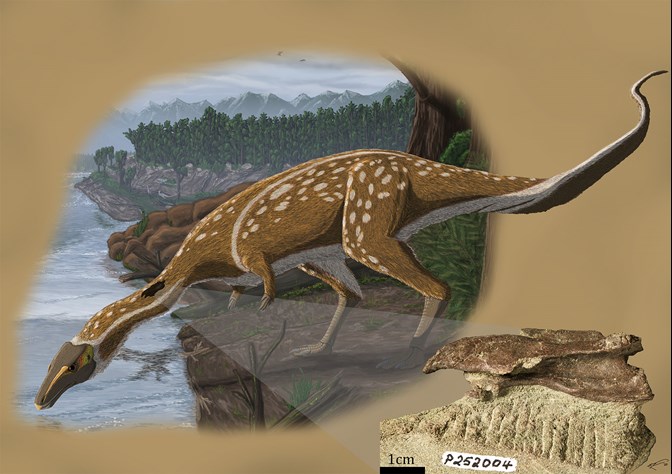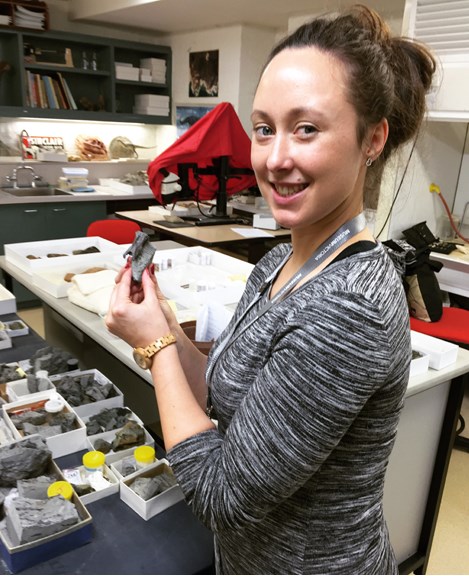Museum fossil leads to discovery of new 110 million year old dinosaur: Australia’s first elaphrosaur
New palaeontology research on a Museums Victoria fossil specimen reveals the first evidence that an unusual toothless dinosaur once roamed Australia, thanks to a chance discovery by a Victorian volunteer dinosaur digger.
In a new paper published in Gondwana Research, palaeontologists from Swinburne University of Technology have described the fossil as belonging to a group of theropods called elaphrosaurs.
The tiny fossilised neck vertebra was recovered in 2015 by keen-eyed Dinosaur Dreaming volunteer Jessica Parker at a fossil site known as Eric the Red West near Cape Otway, Victoria. It was transported to Museums Victoria and extracted from rock by the late David Pickering, Collection Manager of Vertebrate Palaeontology at the time.
Originally thought to belong to a flying pterosaur, palaeontologists Stephen Poropat and Adele Pentland of Swinburne University hit a snag when trying to identify what type of pterosaur it was from.
‘Pterosaur neck vertebrae are very distinctive’ says Pentland. ‘In all known pterosaurs, the body of the vertebra has a socket at the head end, and a ball or condyle at the body end. This vertebra had sockets at both ends, so it could not have been from a pterosaur!’
Extensive research and analysis of the excellently preserved fossil by Poropat and Pentland demonstrated that the vertebra was from a theropod dinosaur, specifically the first fossil of an elaphrosaur ever recognised in Australia.
‘Elaphrosaurs were strange looking dinosaurs - they ran low to the ground on two legs, with a slender body, long neck, stubby arms, and a delicate toothless skull’ explains Tim Ziegler, Collection Manager of Vertebrate Palaeontology at Museums Victoria.
'They started life eating a wide range of foods, but shed their teeth as they aged. Elaphrosaurs are unusual among theropods because adults had a plant-based diet, rather than hunting prey.'
While records from other continents show this dinosaur lived during the Late Jurassic Period, the Victorian elaphrosaur dates to almost 40 million years later, from the Early Cretaceous period.
‘Young elaphrosaurs might have hunted the tiny monotremes (ancestors to platypus and echidna) that lived in polar Victoria, along with snapping up insects and fruits,’ says Ziegler.
Lovingly dubbed ‘Eric the Elaphrosaur’ after its discovery location, this Victorian fossil will now go into the global fossil record to help scientists better understand the complexity of life and ecosystems on Gondwanan continents.
‘New discoveries like this elaphrosaur fossil overturn past ideas, and help to interpret discoveries yet to come' says Tim. ‘The Museums Victoria collection plays an important role in presenting this new aspect of Victoria’s natural heritage and ensuring the public and scientists can learn more about Victoria’s fossil record for generations to come.’
The fossil site at Eric the Red West awaits further exploration, as proposed digs have been postponed twice due to bushfires and the COVID-19 pandemic. Museums Victoria’s Senior Curator of Vertebrate Palaeontology Dr Thomas Rich is confident that when the opportunity arises for further digging at the site, a ‘cornucopia of fossils’ is waiting to be discovered.
Meet the everyday people digging up ancient fossils on the Dinosaur Dreaming Project:
Learn about another fossil discovery from Eric the Red West: Who wielded the Otway Claw?
Dinosaur Dreaming is a joint project run by Museums Victoria and Monash University. Become a Friend of Dinosaur Dreaming and support the excavation of Victorian dinosaurs here.
Museums Victoria: For media enquiries about the fossil specimen with Tim Ziegler or Dinosaur Dreaming with Dr Thomas Rich, please contact:
Swinburne University: Stephen Poropat is available for interview. For media enquiries please contact:
Lea Kivivali, Senior Adviser, Communications and Media
E: [email protected] | M: 0410 569 311









